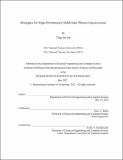Strategies for High-Performance Solid-State Photon Upconversion
Author(s)
Lin, Ting-An
DownloadThesis PDF (6.157Mb)
Advisor
Baldo, Marc A.
Terms of use
Metadata
Show full item recordAbstract
Photon upconversion, a process that converts multiple low-energy photons into higher energies, has promising applications such as photovoltaics, bio-imaging, and photo-chemistry. Among the techniques capable of achieving photon upconversion, manipulating the excited states of organic molecules is especially attractive for practical applications thanks to its capability of being operated with low-intensity incoherent light sources. The performance in solid-state, however, is unsatisfactory for applications due to weak optical absorption, internal losses, and the fundamental limit from the upconverting process—triplet-triplet annihilation (TTA)—itself. In this thesis, we investigate strategies to tackle the limitations in solid-state photon upconversion. First, optical absorption is enhanced via embedding an archetypical solid-state infrared-to-visible upconverter into an optical cavity, which results in 74-fold enhancement in absorption and two-orders-of-magnitude reduction in required excitation intensity down to subsolar flux. Charge-exciton hybrid system is also explored as a second approach to enhance absorption. With detailed mechanism further investigated, the optimized device exhibits 0.04- fold lower excitation intensity without external optical structures. Next, we dive into the internal loss pathways within an upconverter. Consisting of an absorbing and an upconverting layer, solid-state upconverters suffer from back transfer and material aggregation. Here, we demonstrate that a bilayer structure with the absorbing layer diluted into a host material can simultaneously mitigate these losses, which results in 7 times higher efficiency and 6 times lower excitation intensity. Finally, we explore the very interior of photon upconversion—the potential to achieve TTA efficiency beyond its fundamental limit by utilizing high-lying non-emissive excited states. The experimental results manifest our concept as a design rule for further developing limit-breaking TTA molecules. With the strategies to develop high-performance solid-state photon upconverters, we look forward to further advancement in modern technologies that benefit from photon upconversion.
Date issued
2022-05Department
Massachusetts Institute of Technology. Department of Electrical Engineering and Computer SciencePublisher
Massachusetts Institute of Technology